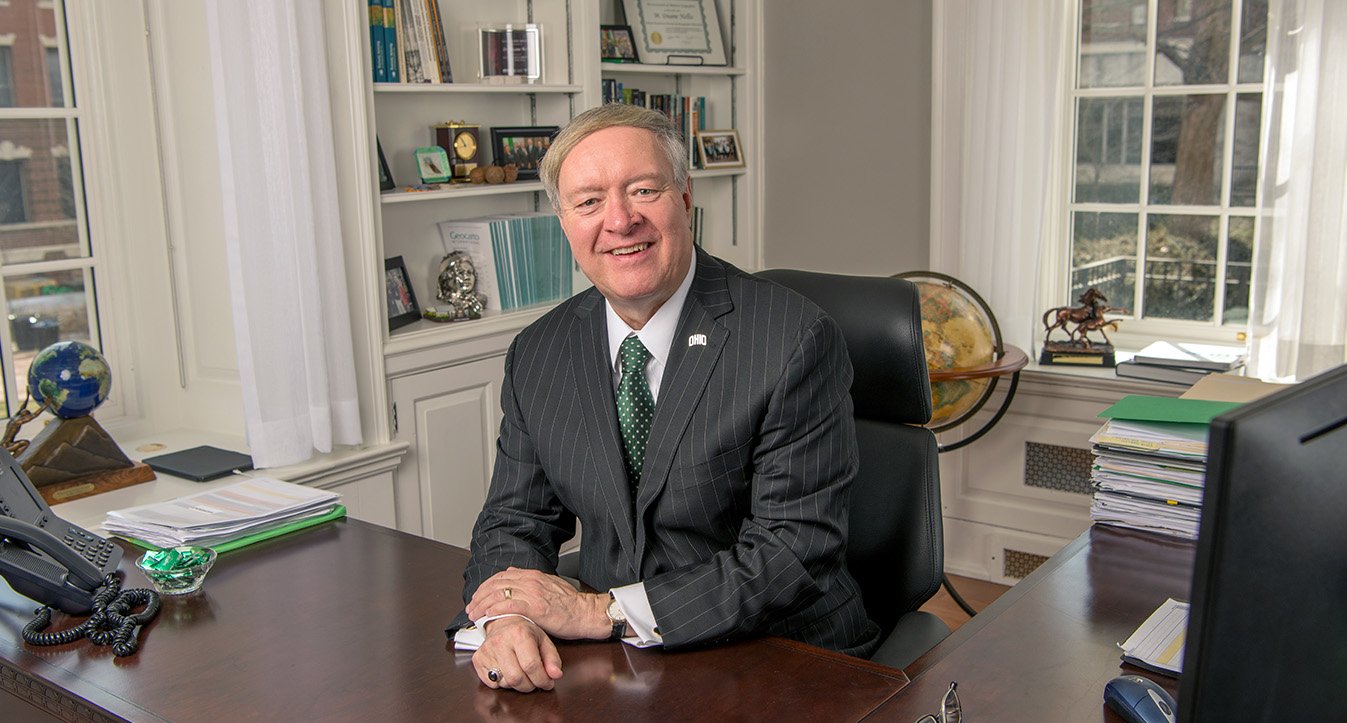
“As your 21st president, I am humbled by the legacy I am inheriting—a legacy that began some 213 years ago on the frontier of a vast wilderness.”
As Ohio University President M. Duane Nellis spoke these words during his formal investiture in October, he described how, in many ways, OHIO still stands on the edge of a vast wilderness.
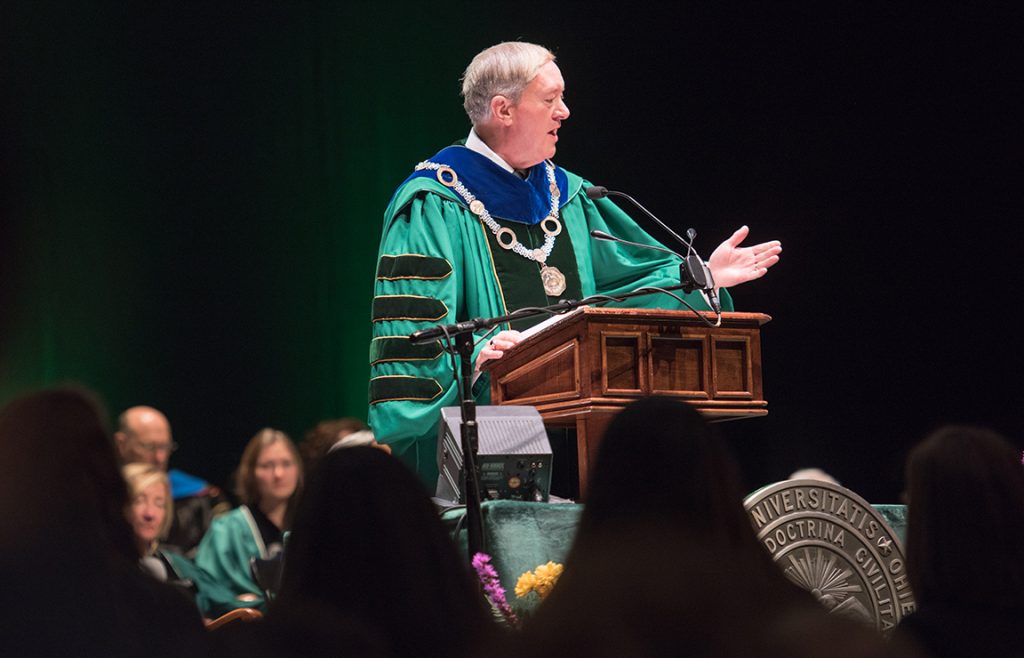
M. Duane Nellis was inaugurated as Ohio University’s 21st president on October 18, 2017. Photo by Ben Wirtz Siegel, BSVC ’02
The pace of change hastens each year, and the role higher education plays in preparing society for an increasingly uncertain future has been less supported and more questioned than ever before.
“When the history of this era is written, I think we will all be remembered for how we responded when our central mission to educate the people of the world was dismissed as simply a ‘waste of money,’” Nellis said in his address.
What will be OHIO’s response to this challenge? A vision—formed out of the collective wisdom of the University community—to not only excel amid this uncertainty, but become a national model for success.
“For me, leadership is not about position. It is about the way in which each of us address the responsibilities we have,” Nellis says.
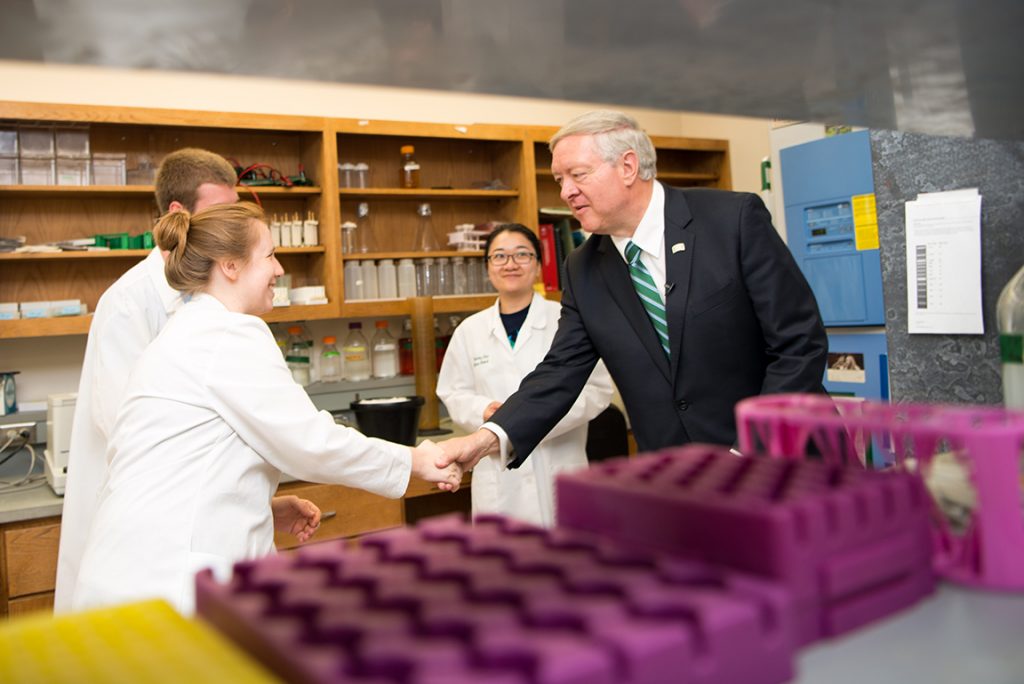
Nellis spent his first weeks in office visiting OHIO’s labs, dining halls, classrooms, and regional campuses. Photo by Ben Wirtz Siegel, BSVC ’02
These informed conversations created the following four strategic pathways and ten strategic priorities, guides for leading the University to new levels of excellence.
Lead the nation in diversity and inclusion
To launch this first pathway, Nellis established a vice president for diversity and inclusion position, a role that OHIO’s Vice President for Student Affairs and Interim Chief Diversity Officer Jason Pina calls, “the gold standard in higher education.”
“With most of the schools that we see being recognized for doing this work, all had vice presidents for diversity and inclusion: people who are not just doing diversity and inclusion work but who are also sitting at the table when major institutional decisions are being made,” Pina explains.
Once seated, the new vice president will be tasked with creating what Nellis sees as “an environment where we’re respectful of everyone and feel that we’re enriched by that diversity as well.”
This enrichment translates into personal empowerment for many students, Pina says.
“[It] creates a community where students can engage as deeply as humanly possible in their own learning; to reinforce how they were raised or to question how they were raised; to expose themselves to lectures and coursework and social situations that really push them to formulate how they’re going to be citizens of the world.”
A diversity and inclusion audit of OHIO was completed in 2017 and a comprehensive survey of the student body on these issues was launched this spring. Pina says today’s student experience might not be the one alumni recognize, but its benefits will be shared by all.
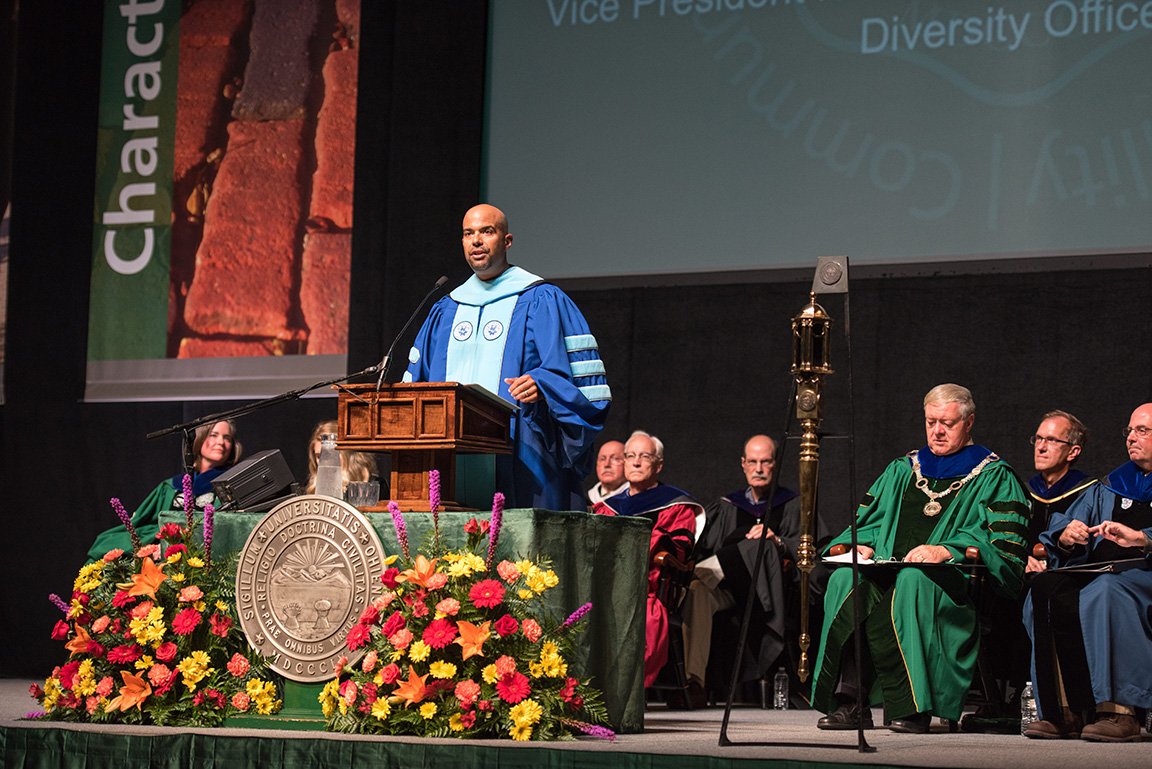
Jason Pina, vice president for student affairs, speaks at the President's Convocation for First-Year Students at the Convocation Center. Photo by Ben Siegel, BSVC '02
Create an expanded honors program
The second pathway will create a University-wide honors program in 2018 that offers students broader access to honors-level academics while preserving the Honors Tutorial College’s offerings. An “OHIO Honors” task force is already turning this idea into a reality. “We didn’t want a traditional academic-only honors program,” says Interim Executive Vice President and Provost Elizabeth Sayrs. “Our students come to Ohio University wanting to be more engaged with their communities, wanting to learn more not just inside the classroom but outside the classroom.” Sayrs says the program will offer a variety of “pathways” to cater to students’ particular interests. Options will include research and creative activity, community engagement, leadership, and others, and each will enhance related programs already in place, creating a “ladder of experiences” beyond the standard curriculum to enhance the student’s degree.
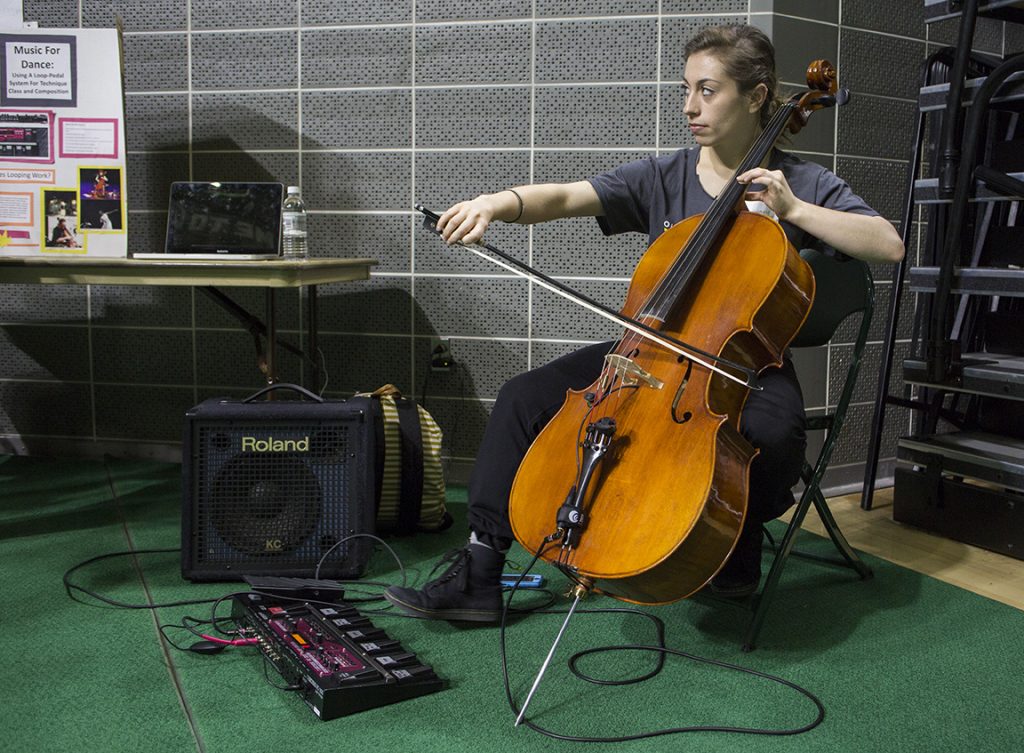
Lily Gelfand, a dance major in the Honors Tutorial College, demonstrates how to use a loop-pedal system at the 2016 Student Research and Creative Activity Expo. Gelfand uses the pedal to loop her live cello music during dance classes and performances. Photo by Emily Matthews, BSVC ’18
Build an engagement ecosystem
The third will foster an “engagement ecosystem” to better connect OHIO students, faculty, and staff to one another and to their communities. Nellis says OHIO is already deeply engaged across the state and region, yet those activities are often decentralized, leaving open the opportunity for collaboration.
As an example, he points to the Ohio region’s opioid crisis. “I would guess that every one of our colleges in one way or another are in some way tied to some dimension that is affected by the opioid crisis. And we have many of those colleges working to try to help, but our colleges historically don’t always know what the other colleges are doing,” Nellis says. “… I think by helping to coordinate those efforts, we can be even more powerful in the impact we have on those communities.”
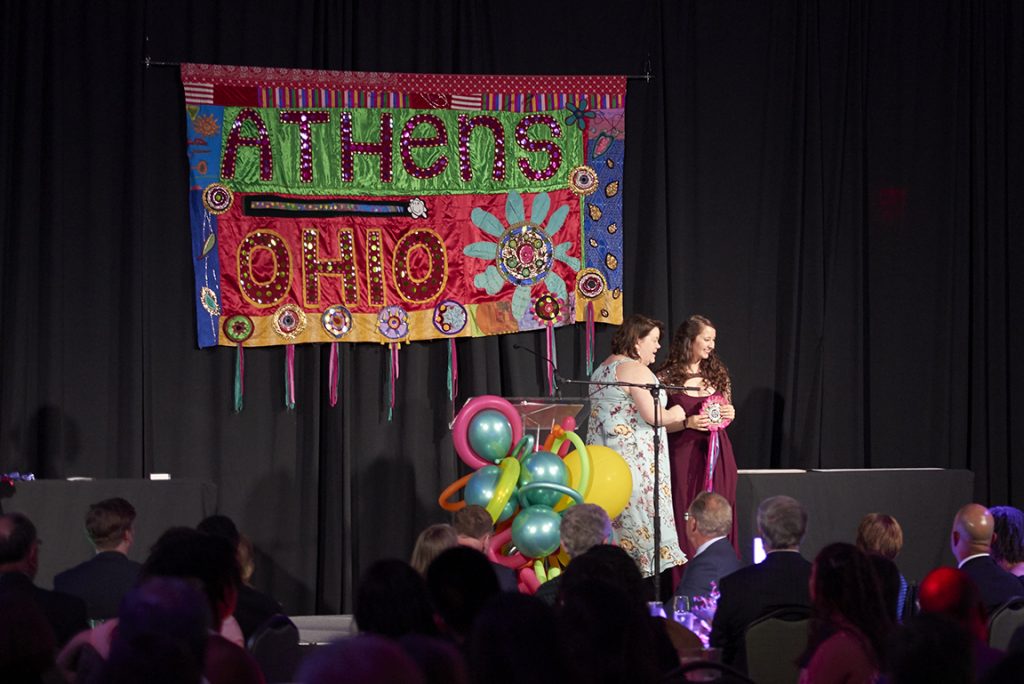
Rachel Ridout is presented with the Kerrigan Family Scholarship Award at the 2018 Student Leadership Awards Gala. Ridout was the creative mind behind the photo series entitled "I stay sober because…” Photo by Evan Leonard, BSVC ’18
Embrace challenging dialogues and civil debate
“This is an institution that has taken great pride … [in] the opportunity for people of many different viewpoints to have a dialogue across the University,” Nellis says. “And although we may not agree with the points of view, there’s a strong tradition here of opportunities of freedom of expression and to have difficult dialogues.” The fourth pathway will bring rigorous, civil debate to campus via a public lecture series that will build on this legacy of activism and civil discourse. OHIO’s George Washington Forum is one venue for showcasing OHIO’s commitment to challenging yet civil discourse.
Read about the George Washington Forum’s efforts in “Difficult dialogues,” appearing in this issue of ohiotoday.org.
“The new world of Ohio University starts here,” Nellis said as he concluded his inaugural address. “We must succeed and be the model, not only for our nation, but the generations that will come after us.”
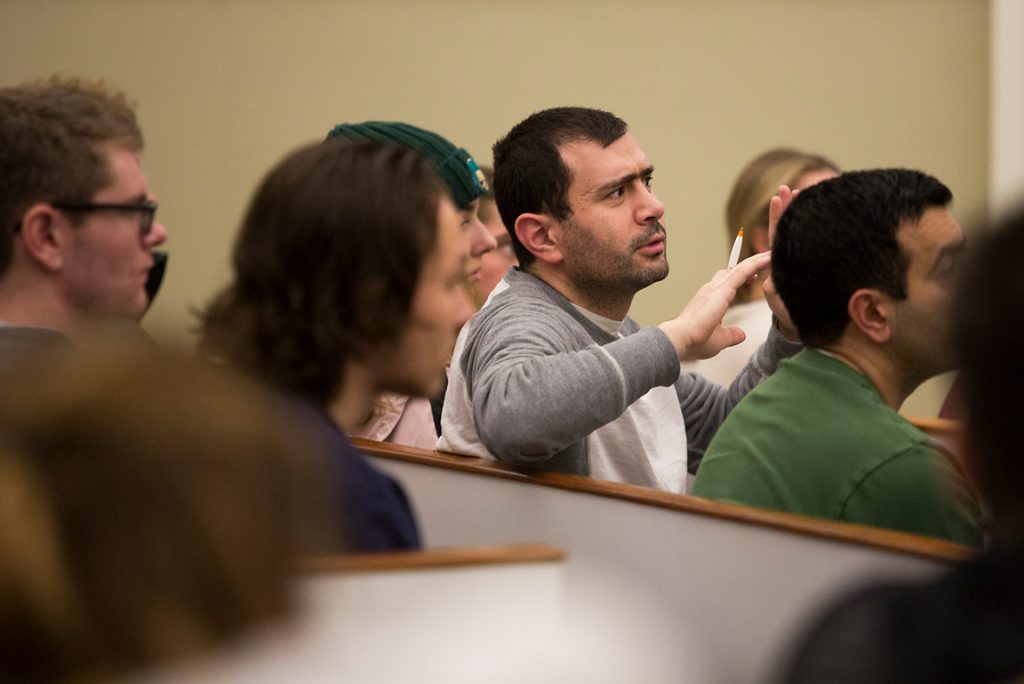
An audience member asks a question during the March 2018 George Washington Forum on “Public Bioethics and Human Identity.” Photo by Madeleine Hordinski, BSVC ’20
Onward
President Nellis identified 10 strategic priorities for OHIO's future that "build on our strengths." Brief descriptions of each follow. By Cat Hofacker, BSJ '18

Bobcats out in the world
Strengthening global engagement efforts OHIO supports students who want to solve problems both on campus and abroad. “It’s about embracing the world on our campus and being willing to go out into the world and experience it,” says Lorna Jean Edmonds, vice provost for global affairs and international studies. One example: OHIO students and faculty partner with the Pontifical Catholic University of Ecuador to explore solutions to food insecurity in both Appalachia and Ecuador.

Teamwork makes the dream work
Incentivizing interdisciplinary collaborations When Bobcats help Bobcats, wonderful things happen. Women’s Center Director Geneva Murray says “borrowing from each other’s areas of expertise” creates tangible benefits for all. “We can’t know everything, so we can’t serve people unless we’re taking advantage of all the amazing talent on campus to make our programs effective,” Murray says.

OHIO Alumni for OHIO
Strategically reconnecting with the University’s 237,000-strong alumni base There are more than 237,000 living Bobcats worldwide, most of whom connect with OHIO in a unique way. Executive Director of Advancement Communication and Marketing Jennifer Bowie says understanding those differences helps OHIO “honor and meet alumni wherever they are. Our best ambassadors are people who know our story, and our alumni know OHIO better than anyone,” Bowie says.

Gratitude for grad students
Enhancing graduate student stipends and related benefits Graduate students are researchers, teaching assistants, office workers, and sometimes breadwinners for their families. OHIO acknowledges their importance on campus and how many must balance their home lives and academics. Beginning this fall, OHIO will provide parental leave for students with graduate assistantships. “Graduate education is a part of what we do, and we want to do it well,” says Joseph Shields, dean of the Graduate College (currently serving as interim dean of the College of Arts and Sciences).

OHIO's citizen-students
Strengthening the University’s public service mission OHIO’s mission is to serve its students and the regional community. New students enrolling annually means new citizens live in each OHIO campus town. This can be a positive force. “When students engage with the community…it increases their understanding of southeastern Ohio,” says Carey Busch, acting dean of University College. “A big part of it is…working in partnership with the communities to understand where the needs are.”

More OHIO online, please
Seeking a more robust OHIO Online Engaged Learning enterprise–the future of online learning Lifelong learning may begin at the undergraduate level, but it doesn’t end there. Not at OHIO. Brad Cohen from the Office of Instructional Innovation says the traditional college model—brick and mortar campuses with mostly undergraduate students enrolled—is changing. “We’re moving toward adult learners because they need us, and what they need is the ability to come back to school without stopping their lives.”

Funding for the future
Enhancing the campus infrastructure and ensuring a sustainable financial model If OHIO is a car, and the pathways for the future are the destination, the financial model is the gas that gets us there. “We’re always considering tomorrow as we make decisions today,” says Deb Shaffer, vice president for OHIO’s Finance and Administration. “It’s understanding where we’re going and what’s our strategy to get there. The finances just follow that.”

OHIO's finest
Supporting the outstanding faculty and staff of Ohio University by investing in them At OHIO’s core is its faculty and staff. “It all starts and ends with the men and women who teach our classes,” says Laura Myers, chief of staff for the executive vice president and provost office. “Faculty and staff are the first and last…in terms of helping our students be the best people they can be.” OHIO also supports creativity and innovation among faculty by offering, for example, workshops and classes through its Office of Instructional Innovation.

OHIO champions sustainability
Enhancing the University’s national position as a leading-edge laboratory for sustainability OHIO integrates sustainable practices at myriad levels. From food purchases to construction, these are long-term investments in the University’s—and the planet’s—future. “Sustainability is a framework for making decisions that benefit our population, our planet, and our prosperity,” says the Office of Sustainability’s Elaine Goetz.

That OHIO "it" factor
Taking our branding and marketing efforts to greater heights by finding new, strategic, consistent, and rhetorically powerful ways to talk about the University Bobcats know there’s something special about OHIO, but can you put your finger on why? “Our students, faculty, staff, and alumni have incredible stories that are ripe for the telling,” says Carly Leatherwood, senior director, Communication Services at University Communications and Marketing. “As we advance our brand we will leverage their voices to clearly define what it means to be an OHIO Bobcat.”



